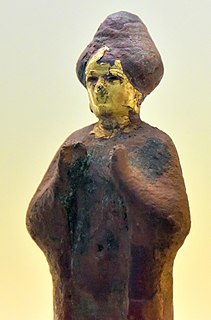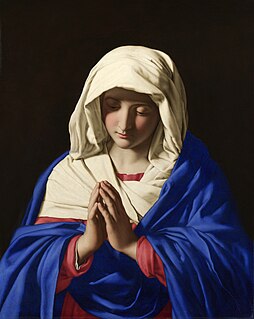
Prayer is an invocation or act that seeks to activate a rapport with an object of worship through deliberate communication. In the narrow sense, the term refers to an act of supplication or intercession directed towards a deity or a deified ancestor. More generally, prayer can also have the purpose of thanksgiving or praise, and in comparative religion is closely associated with more abstract forms of meditation and with charms or spells.

The Holy Rosary, also known as the Dominican Rosary, or simply the Rosary, refers to a set of prayers used in the Catholic Church, and to the physical string of knots or beads used to count the component prayers. When referring to the prayer, the word is usually capitalized ; when referring to the prayer beads as an object, it is written with a lower-case initial letter.

Northern Praying Mantis is a style of Chinese martial arts, sometimes called Shandong Praying Mantis after its province of origin. It was created by Wang Lang (王朗) and was named after the praying mantis, an insect, the aggressiveness of which inspired the style. One Mantis legend places the creation of the style in the Song Dynasty when Wang Lang was supposedly one of 18 masters gathered by the Abbot Fu Ju (福居), a legendary persona of the historical Abbot Fu Yu (福裕) (1203–1275), to improve Shaolin martial arts. However, most legends place Wang Lang in the late Ming Dynasty.

A bell tower is a tower that contains one or more bells, or that is designed to hold bells even if it has none. Such a tower commonly serves as part of a Christian church, and will contain church bells, but there are also many secular bell towers, often part of a municipal building, an educational establishment, or a tower built specifically to house a carillon. Church bell towers often incorporate clocks, and secular towers usually do, as a public service.
Religions with the belief in a future judgment, a resurrection of the dead or a purgatory often offer prayers on behalf of the dead to God.

Intercession or intercessory prayer is the act of asking or requesting to a deity or to a saint in heaven to pray on behalf of oneself or others.

The Litany of the Blessed Virgin Mary is a Marian litany originally approved in 1587 by Pope Sixtus V. It is also known as the Litany of Loreto, after its first-known place of origin, the Shrine of Our Lady of Loreto (Italy), where its usage was recorded as early as 1558.

Intercession of the Saints is a Christian doctrine held by the Eastern Orthodox, Oriental Orthodox, and Catholic churches. The practice of praying through saints can be found in Christian writings from the 3rd century onward. The 4th-century Apostles' Creed states belief in the communion of Saints, which certain Christian churches interpret as supporting the intercession of saints. However, similar practices are controversial in Judaism, Islam, and Protestantism.

The Angelus is a Catholic devotion commemorating the Incarnation of Christ. As with many Catholic prayers, the name Angelus is derived from its incipit—the first few words of the text: Angelus Domini nuntiavit Mariæ. The devotion is practised by reciting as versicle and response three Biblical verses narrating the mystery, alternating with the prayer "Hail Mary". The Angelus exemplifies a species of prayers called the "prayer of the devotee".

The Liturgy of the Hours or Divine Office or Opus Dei are the canonical hours, often also referred to as the breviary, of the Latin Church. The Liturgy of the Hours forms the official set of prayers "marking the hours of each day and sanctifying the day with prayer." The term "Liturgy of the Hours" has been retroactively applied to the practices of saying the canonical hours in both the Christian East and West –particularly within the Latin liturgical rites – prior to the Second Vatican Council, and is the official term for the canonical hours promulgated for usage by the Latin Church in 1971. Before 1971, the official form for the Latin Church was the Breviarium Romanum, first published in 1568 with major editions through 1962.

Teej is the generic name for a number of Hindu festivals that are celebrated by women. Haryali Teej and Hartalika Teej welcome the monsoon season and are celebrated primarily by girls and women, with songs, dancing and prayer rituals. The monsoon festivals of Teej are primarily dedicated to Parvati and her union with Shiva. Women often fast in celebration of Teej.

In the Catholic Church, prayer is "the raising of one's mind and heart to God or the requesting of good things from God." It is an act of the moral virtue of religion, which Catholic theologians identify as a part of the cardinal virtue of justice.

Christian prayer is an important activity in Christianity, and there are several different forms used for this practice.

Eat Pray Love is a 2010 American biographical romantic drama film starring Julia Roberts as Elizabeth Gilbert, based on Gilbert's 2006 memoir of the same name. Ryan Murphy co-wrote and directed the film, which was released in the United States on August 13, 2010. It received mixed reviews from critics, but was a financial success, grossing $204.6 million worldwide against a $60 million budget.

Among Eastern Orthodox and Eastern-Rite Catholic Christians, holy water is blessed in the church and given to the faithful to drink at home when needed and to bless their homes. In the weeks following the Feast of Epiphany, clergy visit the homes of parishioners and conduct a service of blessing using the holy water that was blessed on the Feast of Theophany. For baptism, the water is sanctified with a special blessing.

Mantises are an order (Mantodea) of insects that contains over 2,400 species in about 460 genera in 33 families. The largest family is the Mantidae ("mantids"). Mantises are distributed worldwide in temperate and tropical habitats. They have triangular heads with bulging eyes supported on flexible necks. Their elongated bodies may or may not have wings, but all Mantodea have forelegs that are greatly enlarged and adapted for catching and gripping prey; their upright posture, while remaining stationary with forearms folded, has led to the common name praying mantis.
"Pray the Gay Away?" is a 2011 episode of the American television series Our America with Lisa Ling. The episode, hosted by Ling, profiles several people as they seek to reconcile their homosexuality with their Christianity. It originally aired on OWN: Oprah Winfrey Network on March 8, 2011.

Salah, also known as namāz and also spelled salat, are prayers performed by Muslims. Facing the qibla, the direction of the Kaaba with respect to those praying, Muslims pray first standing and later kneeling or sitting on the ground, reciting prescribed prayers and phrases from the Quran as they bow and prostrate themselves in between. Salah is composed of prescribed repetitive cycles of bows and prostrations, called rakat. The number of rak'ahs, also known as units of prayer, varies from prayer to prayer. Ritual purity and wudu are prerequisites for performing the prayers.

"Pray for Me" is a song by Canadian singer-songwriter the Weeknd and American rapper Kendrick Lamar from the soundtrack album of the Marvel Studios superhero film Black Panther. The song was released by Top Dawg Entertainment, Aftermath Entertainment, and Interscope Records on February 2, 2018, as the album's third and final single. It serves as the second overall collaboration between the two artists. The song appears in the movie during the scene where the titular hero along with his allies, Nakia and Okoye, enter a secret casino in Busan.

Pray for the Wicked is the sixth studio album by American pop rock solo project Panic! at the Disco. The album was released on June 22, 2018 on Fueled by Ramen in the US and WEA internationally. It is the follow-up to the band's fifth studio album, Death of a Bachelor (2016). The album was produced by Jake Sinclair and promoted by the singles "Say Amen ", "High Hopes" and "Hey Look Ma, I Made It", with "(Fuck A) Silver Lining", "Dancing's Not a Crime" and "King of the Clouds" as promotional singles. It received generally positive reviews upon release, with many critics noting Urie's Broadway influences following his performance in Kinky Boots.

















